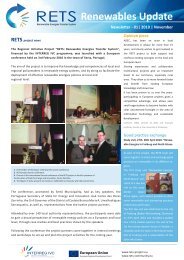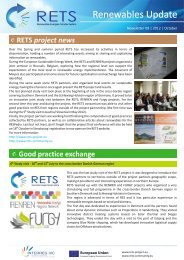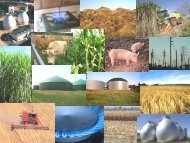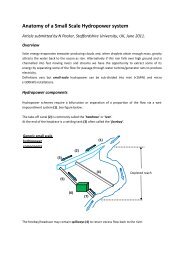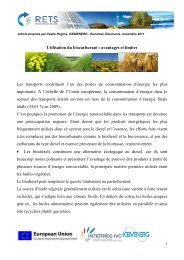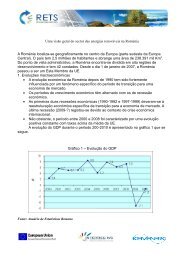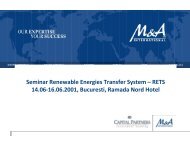Promoting renewable energies - RETS Project
Promoting renewable energies - RETS Project
Promoting renewable energies - RETS Project
Create successful ePaper yourself
Turn your PDF publications into a flip-book with our unique Google optimized e-Paper software.
Solid Biomass Technology<br />
Introduction<br />
Plants use carbon dioxide, water and solar energy as raw<br />
materials to generate biomass. Biomass fuel comes in<br />
many forms including wood, logs, bark, sawdust, straw<br />
and peat (solid biomass),organic waste, manure (wet<br />
biomass),sugar and starch plants(beet, cereals etc.) and<br />
oil crops (rape, sunflower etc.).Biomass fuels can be<br />
used to generate heat, co-generate heat and electricity or<br />
manufacture liquid biofuels for transport applications. At a<br />
first approximation the carbon dioxide released during the<br />
combustion of biomass is neutral as it originated in the<br />
atmosphere.<br />
Average holding size in the public sector (e.g.<br />
municipalities, communes etc.) is much larger where<br />
holding sizes of the order of 1000 hectares are common.<br />
These are typically managed to meet local needs. Public<br />
forest ownership is particularly dominant in most of the<br />
eastern and south-eastern EU Member States.<br />
Agriculture is also becoming an important source of<br />
biomass/bio-fuels as the industry is now encouraged to<br />
grow products to supply current market demand using,<br />
for example, set-aside land and becoming ‘Energy<br />
farmers’.<br />
The European Biomass Association suggests that<br />
biomass energy production could expand to 220 Mtoe<br />
per annum by 2020.<br />
Employment, market development and generating<br />
capacity<br />
The total primary energy production from biomass (2010)<br />
across Europe was reported as being approximately<br />
80 Mtoe with leaders being Germany, France, Sweden<br />
and Finland. Annual solid biomass electricity production<br />
was almost 70,000 million GWh (i.e. 70,000 TWh) across<br />
the region with Germany, Finland, Sweden and Poland<br />
leading the league of generators.<br />
It is estimated that employment linked with the<br />
manufacture and deployment of this technology across<br />
the EU is in excess of 270,000. In general countries at<br />
the top of the installed capacity league table have<br />
mirrored the technological roll-out with jobs.<br />
The market is valued to be around €25,000 million.<br />
Biomass boiler, Wales<br />
EU resource assessment<br />
The forests and other woodlands of the EU account for<br />
approximately 1.7million km 2 of the Union’s surface area.<br />
This is more than more than 40% of total land mass.<br />
These areas are split between private (60%) and public<br />
(40%) ownership. Average holding size in the 16 million<br />
private sector owners is of the order of 13 hectares<br />
however the mode is typically less than 5 hectares.<br />
Research, development and demonstration in the EU<br />
The key areas for biomass research are:<br />
Maximising resource utilisation e.g. use of branch<br />
bark;<br />
Environmentally benign production of BTL (a type<br />
of bio-fuel made from wood or straw);<br />
Development of reliable, cost effective and fuel<br />
flexible biomass gasification technologies for the<br />
small to medium scale (100 MW) power<br />
production;<br />
Efficient emissions and particulates removal;<br />
Algal fuel sources;<br />
New or improved biomass harvesting storage and<br />
logistics.<br />
<strong>RETS</strong> Compendium – © 2012 <strong>RETS</strong> Consortium<br />
27




